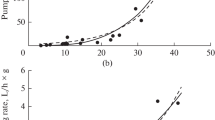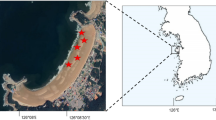Abstract
The gelatinous egg-masses of Clunio marinus (Diptera; Chironomidae) consist of a tube of jelly containing up to 175 eggs. The swimming egg-mass of the Atlantic populations (Race A) and the sinking egg-mass of the Baltic populations (Race B) have a higher density than the sea water, on which the female spawns; salinity is not important to the swimming or sinking of the egg-masses. Density and sinking velocity of gelatinous egg-masses from Atlantic midges are significantly higher than those from Baltic midges if the eggs are laid on water of the same salinity. The density of the eggs and the quantitative relation of eggs to jelly are the same in both races. The jelly of the egg-masses from the Baltic Sea race swells more than that from the Atlantic Sea race (increase of volume by absorption of water = 3-fold and 2.4-fold, respectively). During swelling the jelly alters from a trough-like shape into a tube-like from which closes around the eggs. If the surface tension of the spawning medium is lowered by use of detergents, the A-spawn will sink. A- and B-spawns occupy different positions at an oil-water interface. Interference contrast microscopy revealed that the A-jelly forms a well-defined outer line in relationship to the surrounding aqueous medium; this line is missing in the B-jelly. The morphological fine surface structures, as seen by the scanning electron microscope, do not explain the different properties of the A- and B-spawn. Extracts and hydrolysates of jelly material were separated by thin-layer chromatography. The results indicate that the spawn jelly of C. marinus consists of a polysaccharide-protein-complex, similar to the jellies of other invertebrates. It is rather probable that the chemical structure or the components of the jellies from A- and B-populations are not exactly the same; this would explain the different properties described. The ecological significance of swimming and sinking gelatinous egg-masses and the taxonomical position of both midge populations are discussed.
Similar content being viewed by others
Zitierte Literatur
Aharoni, A. and G. Zweig: On the chemical structure of the apical droplet from eggs of Culex pipiens. J. Insect Physiol. 19, 861–875 (1973)
Baudoin, R.: La physico-chimie des surfaces dans la vie des arthropodes aeriens, des miroirs d'eau, des rivages marins et lacustres et de la zone intercotidale. Bull. Biol. Fr. Belg. 89, 16–164 (1955)
Bert, J.L. and I. Fatt: Relation of water transport to water content in swelling biological membranes. Adv. exp. Med. Biol. 7, 287–294 (1970)
Billard, G. et C. Bruyant: Sur un mode particulier de locomotion de certains Stenus. C. r. Soc. Biol. 59, 102–103 (1905)
Caspers, H.: Rhythmische Erscheinugen in der Fortpflanzung von Clunio marinus (Dipt. Chiron.) und das Problem der lunaren Periodizität bei Organismen. Arch. Hydrobiol. (Suppl.) 18, 415–594 (1951)
Chevrel, R.: Sur un diptère marin du genre Clunio Haliday. Archs Zool. exp. gén. 3, 583–598 (1894)
Christophers, S.R.: Structure of the Culex egg and egg raft in relation to function (Diptera). Trans. R. ent. Soc. Lond. 95, 25–34 (1945)
D'Ans, J. und E. Lax: Taschenbuch für Chemiker und Physiker, 1896 pp. Berlin: Springer-Verlag 1943
Endraß, U.: Physiologische Anpassungen eines marinen Insekts. I. Die zeitliche Steuerung der Entwicklung. Mar. Biol. 34, 361–368 (1976)
Folch, J., M. Ascoli, M. Lees, J.A. Meath and F.N. LeBaron: Preparation of lipid extracts from brain tissue. J. biol. Chem. 191, 833–841 (1951)
— and M. Lees: Proteolipides, a new type of tissue lipoprotein; their isolation from brain. J. biol. Chem. 191, 807–817 (1951)
Hinton, H.E.: Structure and protective devices of the egg of the mosquito Culex pipiens. J. Insect Physiol. 14, 145–161 (1968)
Hotta, K., H. Hamazaki, M. Kurokawa and S. Isaka: Isolation and properties of a new type of sialopolysaccharide-protein-complex of the jelly coat of sea urchin eggs. J. biol. Chem. 245, 5434–5440 (1970a)
—, M. Kurokawa and S. Isaka: Isolation and identification of two sialic acids from the jelly coat of sea urchin eggs. J. biol. Chem. 245, 6307–6311 (1970b)
Hunt, S.: Polysaccharide-protein-complexes in invertebrates, London, New York: Academic Press 1970
Iltis, W.G. and G. Zweig: Surfactant in apical drop of eggs of culicine mosquitoes. Ann. ent. Soc. Am. 55, 409–415 (1962)
Jacobs, J.: Untersuchungen zur Funktion und Evolution der Zyklomorphose bei Daphnia, mit besonderer Berücksichtigung der Selektion durch Fische. Arch. Hydrobiol. 62, 467–541 (1967)
Jacobs, W.: Das Problem des spezifischen Gewichts bei Wassertieren. Arch. Hydrobiol. 34, 432–457 (1943)
Koskinen, R.: Seasonal emergence of Clunio marinus Hal. in Western Norway. Annls zool. fenn. 5, 71–75 (1968)
Lees, A.D. and J.W.L. Beament: An egg-waxing organ in ticks. Q. Jl miscrosc. Sci. 89, 291–332 (1948)
Linderstrøm-Lang, K., O. Jacobsen and G. Johansen: On the measurement of the deuterium content in mixtures of H2O and D2O. C.r. Trav. Lab. Carlsberg (Sér. chim.) 23, 17–25 (1938)
McLintock, J.: The continuous laboratory rearing of Culiseta inornata (Will.) and a study of the structure and function of the egg shell and the egg raft, 51 pp. Doctoral thesis, McGill University, Quebec 1951
Neuberger, A. and R.D. Marshall: Methods for the qualitative and quantitative analysis of the component sugars. In: Glycoproteins. Ed. by A. Gottschalk. Amsterdam, London, New York: Elsevier Publishing Co. 1966
Neumann, D.: Die intraspezifische Variabilität der lunaren und täglichen Schlüpfzeiten von Clunio marinus (Diptera; Chironomidae). Verh. dt. zool. Ges. 1965, 223–233 (1965)
— Die lunare und tägliche Schlüpfperiodik der Mücke Clunio. Steuerung und Abstimmung auf die Gezeitenperiodik. Z. vergl. Physiol. 53, 1–61 (1966)
—: Eine nicht-reziproke Kreuzungssterilität zwischen ökologischen Rassen der Mücke Clunio marinus. Oecologia (Berl.) 8, 1–20 (1971)
Olander, R. and E. Palmén: Taxonomy, ecology and behaviour of the northern Baltic Clunio marinus Halid. (Dipt. Choronomidae). Annls zool. fenn. 5, 97–110 (1968)
Osgood, C.E.: An oviposition pheromone associated with the egg rafts of Culex tarsalis. J. econ. Ent. 64, 1038–1041 (1971)
Pflüger, W.: Die Sanduhrsteuerung der gezeitensynchrone Schlüpfrhytmik der Mücke Clunio marinus im arktischen Mittsommer. Oecologia (Berl.) 11, 113–150 (1973)
Remane, A.: Okologie des Brackwassers. In: Die Binnengewässer. Band 22. Die Biologie des Brackwassers, pp 1–216. Hrsg. von A. Thienemann. Stuttgart: E. Schweizerbart'sche Verlagsbuchhandlung 1958
Sandford, P.A., A.J. Nafziger and A. Jeanes: Reaction of sodium hypochlorite with aminos and amides. A new method for quantitating polysaccharides containing hexosamines. Analyt. Biochem. 44, 111–121 (1971)
Smith, R.I.: D2O uptake in two brackish-water nereid polychaetes. Biol. Bull. mar. biol. Lab., Woods Hole 126, 142–149 (1964)
Stahl, E.: Dünnschichtchromatographie. Ein Laboratoriumshandbuch, 979 pp. Berlin, Heidelberg, New York: Springer-Verlag 1967
Starrat, A.N. and C.E. Osgood: An oviposition pheromone of the mosquito Culex tarsalis: diglyceride composition of the active fraction. Biochim. biophys. Acta 280, 187–193 (1972)
Wolf, K.L.: Physik und Chemie der Grenzflächen. Bd. 2. Die Phänomene im Besonderen, 360 pp. Berlin: Springer-Verlag 1959
Author information
Authors and Affiliations
Additional information
Communicated by O. Kinne, Hamburg
Rights and permissions
About this article
Cite this article
Endraß, U. Physiologische Anpassungen eines marinen insekts. II. Die Eigenschaften von schwimmenden und absinkenden Eigelegen. Marine Biology 36, 47–60 (1976). https://doi.org/10.1007/BF00388428
Accepted:
Issue Date:
DOI: https://doi.org/10.1007/BF00388428




